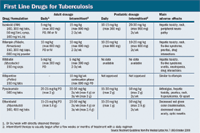Tuberculosis treatment requires medication and monitoring
Poor adherence is the most common cause of treatment failure. Months of treatment and observation produces improvement
Tuberculosis (TB) continues to be a problem in the United States, particularly among at-risk populations. The groups at highest risk for TB include people living with someone who has active disease, and those with a lowered immune response, such as HIV patients.
"Every medical center in our region has tuberculosis on its risk assessment list, that is, its list of potential issues to monitor on a continuing basis," says Stephen Parodi, MD, chief of infectious disease for Kaiser Permanente, Northern California. "We make it a priority to ensure that patients at risk for infection with TB are screened for latent infections."

Most people infected with tuberculosis don't have any symptoms. When a patient is positive for latent TB, the clinician looks at the risk factors and determines (based on criteria from the Centers for Disease Control) whether the person is a candidate for preventive medicine.
"Preventive medicine is a lot easier than treating the active form of the disease," Dr. Parodi says. "With latent disease we can treat with one drug, as opposed to active disease, where we typically have to use a minimum of four drugs initially."
Patients who develop active TB experience symptoms such as weight loss, fever, night sweats, cough, chest pain and bloody sputum.
"Until susceptibility results are available, empiric initial treatment for active TB should include four drugs: isoniazid, rifampin, pyrazinamide and ethambutol," says Mark Abramowicz, MD, editor-in-chief of The Medical Letter on Drugs and Therapeutics, a non-profit newsletter that critically appraises drugs. "When susceptibility to isoniazid, rifampin and pyrazinamide has been documented, ethambutol can be omitted."
DIRECT PATIENT OBSERVATION NEEDED
One of the greatest problems in TB treatment today is the emergence of drug-resistant strains of the bacteria.
"Poor adherence to TB therapy is the most common cause of treatment failure, and can lead to drug resistance," says Dr. Abramowicz. "Medical Letter consultants recommend that most patients, including those with disease due to drug-susceptible strains, take drugs for active TB under direct observation."
At Kaiser, patients with active TB are monitored closely, typically with a monthly office visit. Kaiser physicians sign the orders for directly observed therapy, which is provided by the county public health department.
"We provide medications, lab testing to monitor potential side effects, symptom assessments, and imaging, x-rays or CT scans as needed," Dr. Parodi says. "Protocols differ from jurisdiction to jurisdiction in terms of exactly who gets directly observed therapy, but in our experience, most counties are aggressive. If there is an identified case of active, potentially contagious TB, that person is receiving directly observed therapy."
Extensively drug-resistant TB is a form of the disease caused by strains that are resistant to all the most effective anti-TB drugs. The World Health Organization reports that 41 countries have cases of extensively drug-resistant TB, including the United States.
David Calabrese of OptumRx Talks New Role, Market Insulin Prices and Other Topics 'On His Mind'
April 13th 2023In this month’s episode of the "What's On Your Mind podcast," Peter Wehrwein, managing editor of MHE connects with the now Chief Clinical Officer of OptumRx Integrated Pharmacies, David Calabrese. In this conversation, David touches on his transition in January as OptumRx’s former chief pharmacy officer and market president of health plans and PBMs to his new role as Chief Clinical Officer where he now focuses more on things such as specialty pharmacy to home delivery — with an overall goal of creating whole-patient care. Throughout the conversation, Calabrese also touched on the market’s hot topic of insulin prices and behavioral health services within the OptumRx community, among other topics.
Listen
Briana Contreras, editor of Managed Healthcare Executive, spoke with Nancy Lurker, CEO and president of EyePoint Pharmaceuticals. Nancy shared a bit about EyePoint and how the organization’s innovative therapies are addressing patient needs through eye care, and most importantly, she addressed C-Suite positions like the CEO role. Nancy shared advice for those seeking to reach the CEO level, especially toward women in healthcare and other roles, and what it takes to run a biopharma company.
Listen